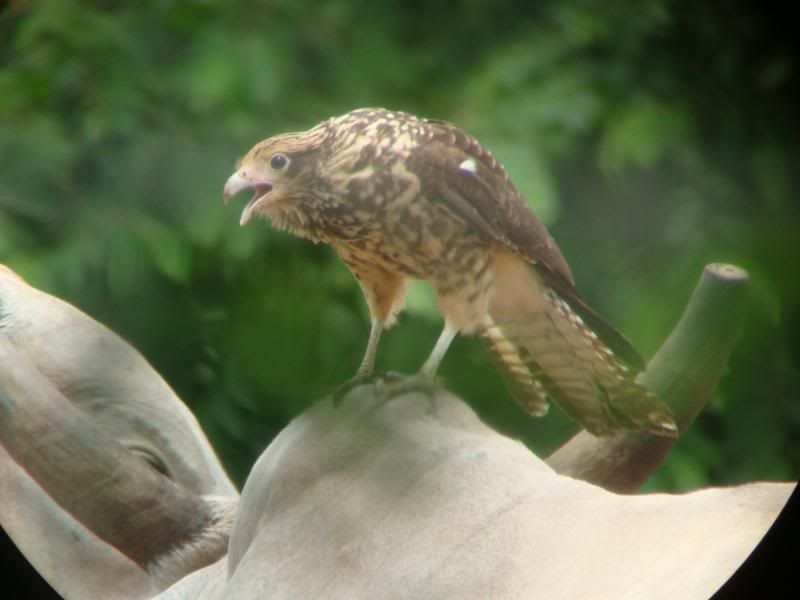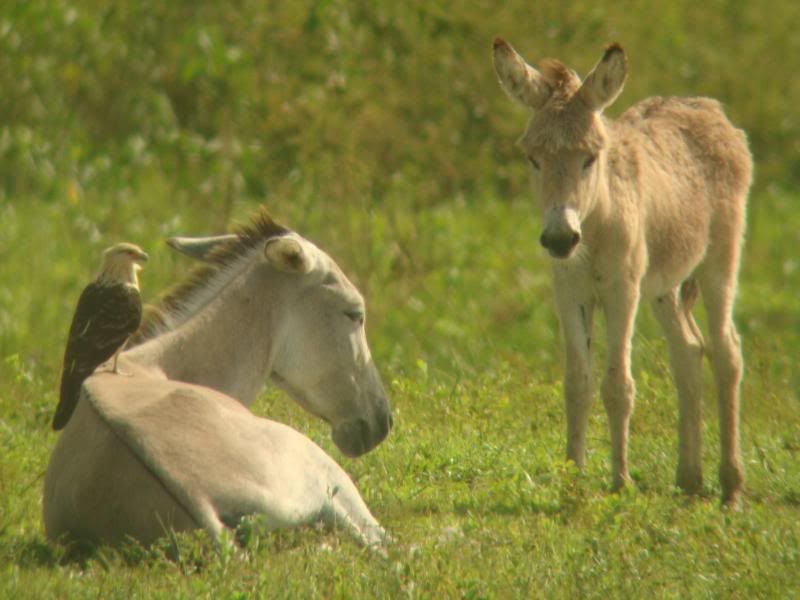
While we are stuck dodging pies, some birds have adapted well to the presence of these smelly beasts. The lumbering beasts kick up insects with their trampling and grass-munching habits, providing easy foraging for birds. Some birds, most notably the Oxpeckers (Buphagidae) of Africa, go so far as a mutualistic (win-win) relationship, picking and eating parasites off the mammals in exchange for a free ride.
Another African mammal-follower has undergone one of the greatest natural range expansions in the last 100 years - the Cattle Egret (Bubulcus ibis). Of course one could argue that their colonization of North and South America, Australia, and range expansions in their native Old World was still human-assisted, what with the abundance of domesticated mammals worldwide providing a proxy for their original habits of following grassland mammals. However you view their origin, they are now a regular sight in agricultural areas in Venezuela and just about everywhere else. They are one of the most common waders (I use the term loosely, they shun water and prefer pasture more than most other herons) on Hato Masaguaral, following the cattle, horses and pigs around in the extensive pastures.

Cattle Egret foraging (video courtesy of Rae Okawa)
If embed doesn't work: link
In the Venezuelan llanos and elsewhere in South America, Cattle Egrets are not alone in their mammal-following habits. They are joined by a rather unlikely mammal-lovers - the Yellow-headed Caracara (Milvago chimachima), a member of the family Falconidae. It seems odd to see a mid-sized raptor hunting insects around mammals, yet they are frequently spotted using cattle for a perch as they watch for kicked-up prey. They also readily provide the cattle with deticking services.
Juvenile (top) and adult (bottom) Yellow-headed Caracara (Photos courtesy of Rae Okawa)


Yellow-headed Caracara ticking (video courtesy of Rae Okawa)
The Caracara and Egret have nothing on the third common mammal-lover of Hato Masaguaral (and real subject of this post). This fearsome bird leaves cows trembling, horses whinnying, and pigs quaking with fear - it is the mighty Cattle Tyrant (Machetornis rixosus).

Okay, so they're not really that imposing, but don't they deserve a little recognition for their awesome despotic name?
In North America, tyrant flycatchers (Tyrannidae) are represented by such drab look-alike birds as Empidonax flycatchers, phoebes (Sayornis), and pewees (Contopus). In Central and South America, Tyrannids explode in species numbers, morphological and color diversity, and ecological habits. The Cattle Tyrant is one of the flycatchers that has adapted to open habitats and is particularly fond of the mutalistic mammal-loving foraging style. They don't just stick to their namesake - they freely exert their will over horses, pigs, capybara, and anyone else weak enough to subjugate.
This trio of dictators kept me entertained one afternoon as they directed their hog peon to forage this way and that.




Cattle Tyrants are the only member of their genus, Machetornis, and belong in the tyrannine clade of flycatchers - the 'true tyrants' (Ohlson et al 2008). Other members of this group include the familiar kingbirds (Tyrannus) and the diverse assemblage of kiskadees (Pitangus) and what I refer to as the 'kiskadee-patterned' flycatchers (Myiozetetes, Megarhynchus, etc) that are common and widespread in the neotropics. Machetornis does show shape and pattern affinities with the tyrannines, including the presence of a hidden colorful crown patch:


With pressure from their tyrannid overlords and the constant nipping from egrets and caracara, it's no wonder that sometimes the cattle break under the strain.

References
Ohlson J, Fjeldsa J, Ericson P (2008) Tyrant flycatchers coming out in the open: phylogeny and ecological radiation of Tyrannidae (Aves, Passeriformes). Zoologica Scripta 37(3):315-335.
The Caracara and Egret have nothing on the third common mammal-lover of Hato Masaguaral (and real subject of this post). This fearsome bird leaves cows trembling, horses whinnying, and pigs quaking with fear - it is the mighty Cattle Tyrant (Machetornis rixosus).

Okay, so they're not really that imposing, but don't they deserve a little recognition for their awesome despotic name?
In North America, tyrant flycatchers (Tyrannidae) are represented by such drab look-alike birds as Empidonax flycatchers, phoebes (Sayornis), and pewees (Contopus). In Central and South America, Tyrannids explode in species numbers, morphological and color diversity, and ecological habits. The Cattle Tyrant is one of the flycatchers that has adapted to open habitats and is particularly fond of the mutalistic mammal-loving foraging style. They don't just stick to their namesake - they freely exert their will over horses, pigs, capybara, and anyone else weak enough to subjugate.
This trio of dictators kept me entertained one afternoon as they directed their hog peon to forage this way and that.




Cattle Tyrants are the only member of their genus, Machetornis, and belong in the tyrannine clade of flycatchers - the 'true tyrants' (Ohlson et al 2008). Other members of this group include the familiar kingbirds (Tyrannus) and the diverse assemblage of kiskadees (Pitangus) and what I refer to as the 'kiskadee-patterned' flycatchers (Myiozetetes, Megarhynchus, etc) that are common and widespread in the neotropics. Machetornis does show shape and pattern affinities with the tyrannines, including the presence of a hidden colorful crown patch:
Cattle Tyrant orange head patch just visible

Lesser Kiskadee (Philohydor lictor) yellow head patch

With pressure from their tyrannid overlords and the constant nipping from egrets and caracara, it's no wonder that sometimes the cattle break under the strain.

References
Ohlson J, Fjeldsa J, Ericson P (2008) Tyrant flycatchers coming out in the open: phylogeny and ecological radiation of Tyrannidae (Aves, Passeriformes). Zoologica Scripta 37(3):315-335.
Very enjoyable post. I'm glad you're up and writing sir.
ReplyDeleteBp
Thanks! I'm glad I am too. It's been real slow going because I've been so busy. I'm on what, a five-month lag in posts now? I'm still in September.
ReplyDeleteHa, this is an awesome post, Nick. i appreciate the explanation of the Cattle Tyrant's family tree. It sure looks like a kingbird to me.
ReplyDeleteThanks, Mike! :)
ReplyDelete